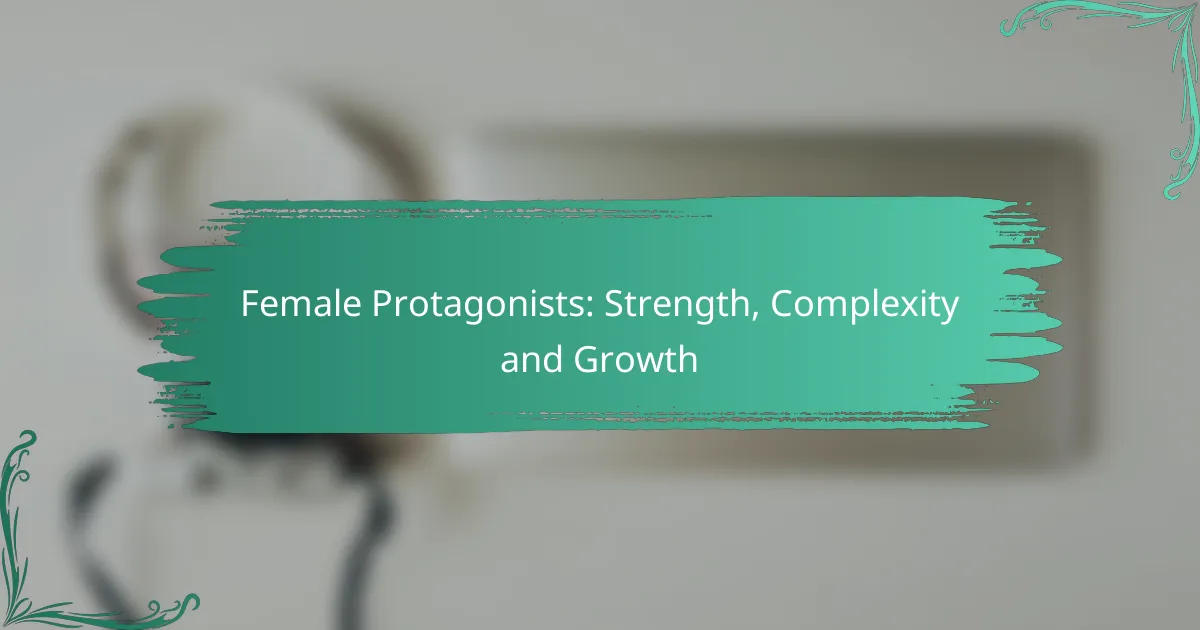Female protagonists serve as powerful representations of strength, complexity, and growth in literature and media. They navigate challenges with resilience and assert their identities, often facing internal conflicts and societal pressures that shape their journeys. Through these multi-dimensional characters, audiences witness profound emotional and psychological transformations that highlight their compelling narratives.
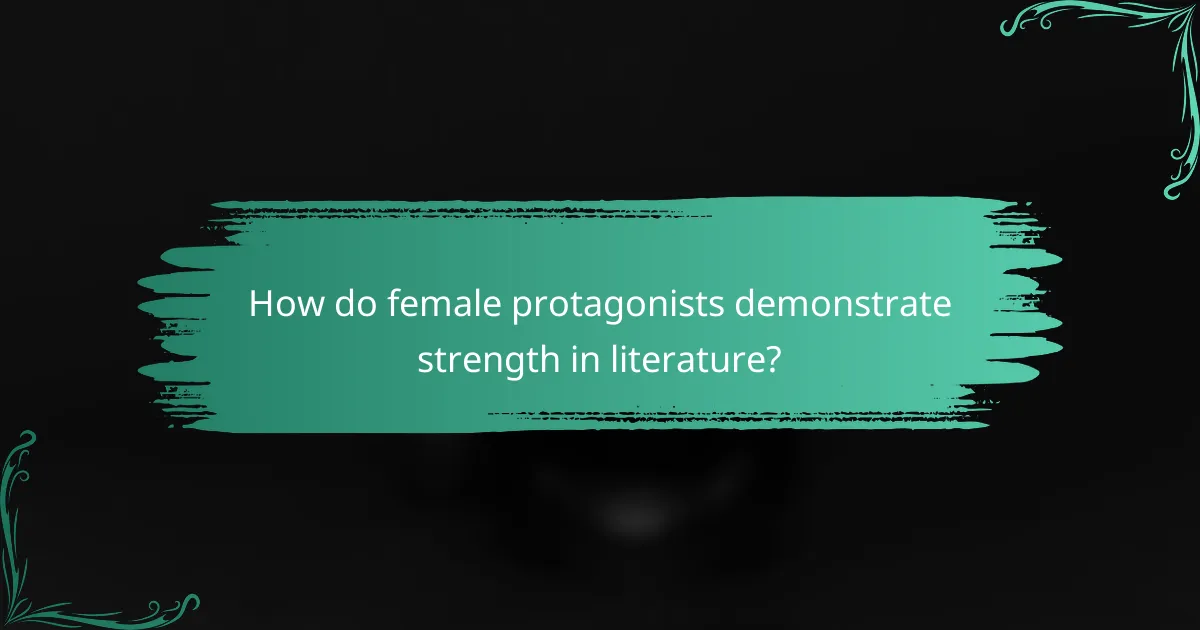
How do female protagonists demonstrate strength in literature?
Female protagonists often exhibit strength through their ability to confront challenges, evolve in complex ways, and assert their identities. This strength is portrayed in various forms, including resilience, leadership, and empowerment in the face of adversity.
Empowerment through adversity
Female protagonists frequently gain empowerment by overcoming significant obstacles. These challenges can range from personal struggles, such as battling societal expectations, to external conflicts like war or discrimination. The journey through adversity not only showcases their strength but also allows for profound character development.
For example, characters like Katniss Everdeen from “The Hunger Games” and Elizabeth Bennet from “Pride and Prejudice” illustrate how facing hardships can lead to self-discovery and empowerment. Their experiences compel them to challenge the status quo and assert their agency.
Leadership roles in narratives
Many female protagonists take on leadership roles that highlight their strength and capability. These characters often lead others in critical situations, demonstrating strategic thinking and emotional intelligence. Their leadership is not just about authority but also about inspiring and uniting those around them.
For instance, characters like Daenerys Targaryen from “Game of Thrones” and Hermione Granger from “Harry Potter” embody leadership through their actions and decisions, often guiding others toward a common goal while navigating complex moral dilemmas.
Physical and emotional resilience
Physical and emotional resilience is a hallmark of strong female protagonists. These characters often endure physical challenges, such as combat or survival scenarios, while also navigating emotional turmoil, including loss, betrayal, or identity crises. Their ability to withstand and adapt to these pressures showcases their multifaceted strength.
Examples include Wonder Woman, who embodies physical prowess alongside emotional depth, and Jane Eyre, whose emotional resilience allows her to confront societal and personal challenges. Both characters illustrate that strength is not solely about physicality but also about mental fortitude and emotional growth.
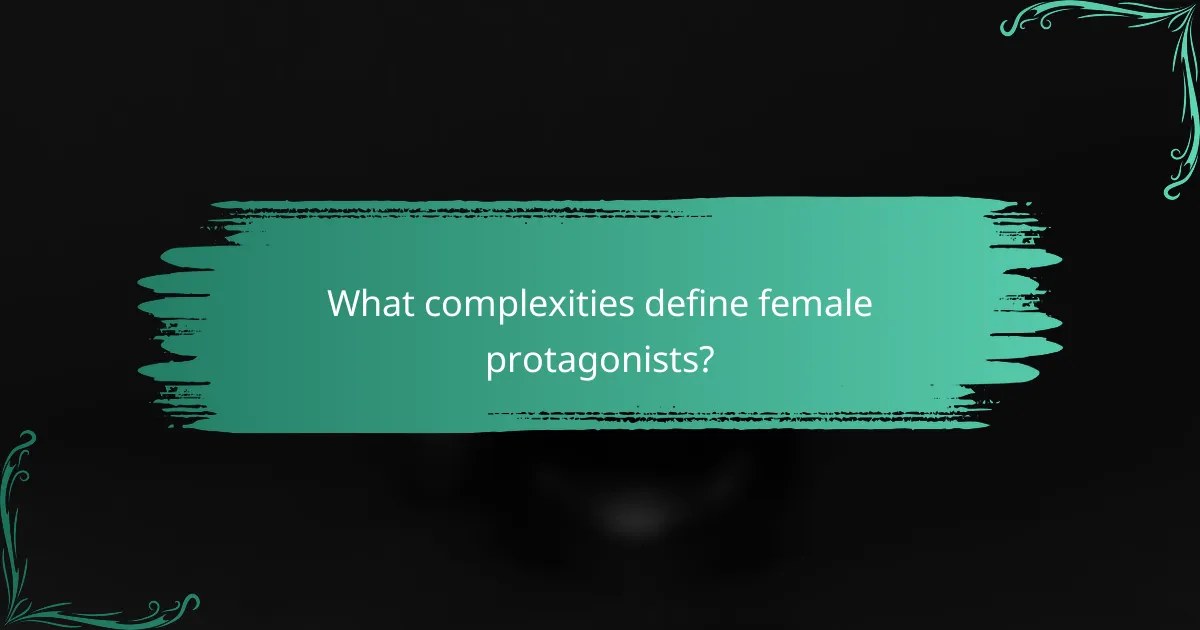
What complexities define female protagonists?
Female protagonists are often characterized by their multi-dimensional traits, internal conflicts, and the pressures of societal expectations. These complexities contribute to their growth and development throughout a narrative, making them relatable and compelling.
Multi-dimensional character traits
Female protagonists frequently exhibit a blend of strengths and vulnerabilities, which makes them relatable and realistic. Traits such as resilience, empathy, and intelligence are often balanced with flaws like insecurity or impulsiveness. This combination allows for rich character arcs that resonate with audiences.
For example, a female lead might be a successful businesswoman facing self-doubt, or a single mother struggling to balance career ambitions with family responsibilities. These traits create depth and invite readers to engage with their journeys on multiple levels.
Conflicts and moral dilemmas
Conflicts faced by female protagonists often revolve around personal choices and societal pressures. They may grapple with decisions that challenge their values, such as choosing between career advancement and family obligations. These moral dilemmas highlight the complexities of their lives and the stakes involved in their choices.
Consider a character torn between loyalty to a friend and the need to stand up for what is right. Such conflicts not only drive the plot but also facilitate character growth as they navigate these challenging situations.
Relationships and societal expectations
Relationships play a crucial role in shaping female protagonists, influencing their decisions and personal growth. Whether it’s friendships, romantic partnerships, or familial ties, these connections often reflect societal expectations that can be both supportive and restrictive.
For instance, a protagonist might face pressure to conform to traditional gender roles while striving for independence. This tension can lead to transformative experiences that challenge societal norms and redefine their identity.

How do female protagonists evolve throughout their stories?
Female protagonists typically evolve through a combination of character development, challenges faced, and personal growth. Their journeys often reflect complex emotional and psychological transformations that resonate with audiences.
Character arcs and growth
Character arcs are essential in illustrating how female protagonists change throughout their narratives. These arcs can range from a simple realization to profound transformations that redefine their identities. For instance, a character may start as timid and gradually become assertive, showcasing a journey of empowerment.
Writers should consider the motivations behind these changes, ensuring they are rooted in the character’s experiences and relationships. A well-crafted arc not only enhances the protagonist’s depth but also engages the audience, making them invested in the character’s journey.
Transformation through challenges
Challenges serve as catalysts for transformation in female protagonists. Whether facing societal expectations, personal loss, or moral dilemmas, these obstacles compel characters to confront their fears and limitations. For example, a character might struggle against gender norms in a patriarchal society, ultimately finding her voice and strength.
It’s crucial to depict these challenges realistically, allowing for relatable struggles that reflect the complexities of real life. This authenticity helps audiences connect with the protagonist’s journey, fostering empathy and understanding.
Lessons learned and personal development
As female protagonists navigate their stories, they often emerge with valuable lessons that contribute to their personal development. These lessons can range from understanding the importance of friendship to recognizing their own worth. For instance, a character who initially seeks validation from others may learn to appreciate her own strengths.
Writers should highlight these lessons through pivotal moments in the narrative, ensuring they resonate with the audience. By showcasing the protagonist’s growth and the insights gained, the story becomes not only a journey of self-discovery but also an inspiring narrative that encourages readers to reflect on their own lives.
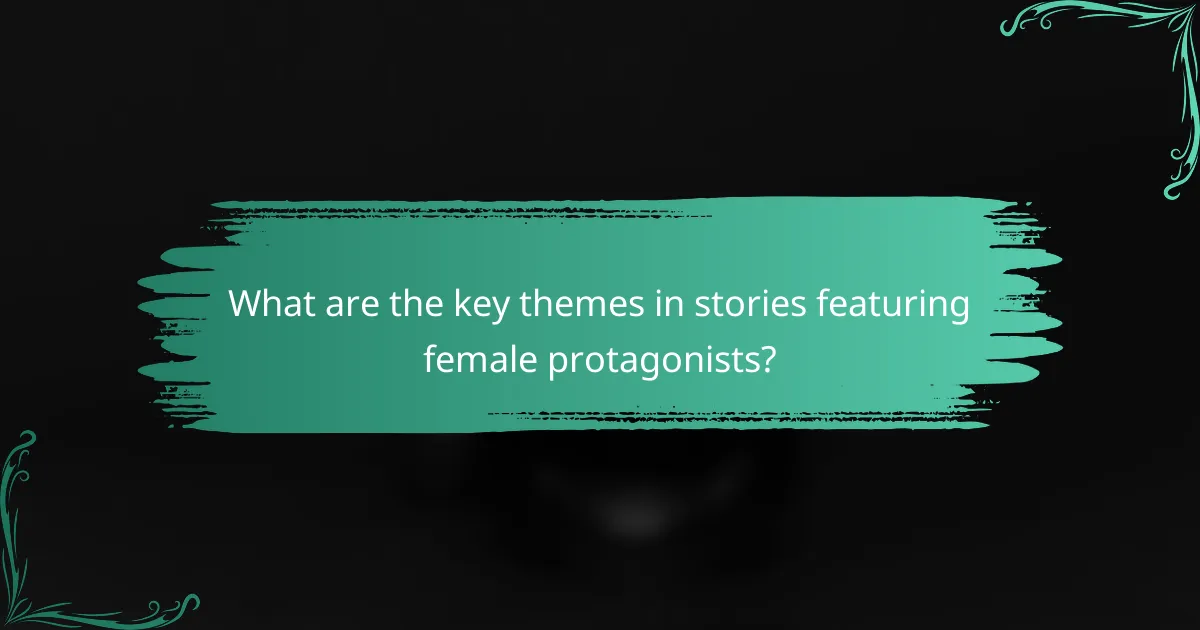
What are the key themes in stories featuring female protagonists?
Key themes in stories with female protagonists often include identity and self-discovery, feminism and social justice, and friendship and solidarity. These themes highlight the complexities and strengths of female characters as they navigate their journeys and relationships.
Identity and self-discovery
Identity and self-discovery are central to many narratives featuring female protagonists. These stories often explore the characters’ journeys to understand themselves, their values, and their place in the world. For example, a character may grapple with societal expectations while striving to embrace her true self.
As female protagonists confront challenges, they often experience significant growth. This can involve overcoming personal obstacles or societal pressures, leading to a deeper understanding of their identities. Readers can relate to these struggles, making the characters’ journeys resonate on a personal level.
Feminism and social justice
Feminism and social justice are prominent themes in stories with female leads, reflecting the ongoing fight for equality and representation. These narratives often depict women challenging patriarchal structures, advocating for their rights, and supporting marginalized communities. Such stories can inspire readers to engage with social issues and consider their roles in promoting justice.
Characters may take various forms of action, from grassroots organizing to personal acts of defiance, showcasing the diverse ways women can effect change. This theme encourages discussions about the importance of solidarity and activism in achieving gender equality and social justice.
Friendship and solidarity
Friendship and solidarity among female characters are crucial themes that highlight the power of community. These stories often showcase how women support each other through shared experiences, fostering resilience and empowerment. Strong friendships can serve as a source of strength, helping characters navigate life’s challenges together.
In many narratives, the bonds between female characters are portrayed as essential to their growth and success. These relationships can provide emotional support, practical assistance, and a sense of belonging, illustrating the importance of solidarity in overcoming obstacles and achieving personal goals.
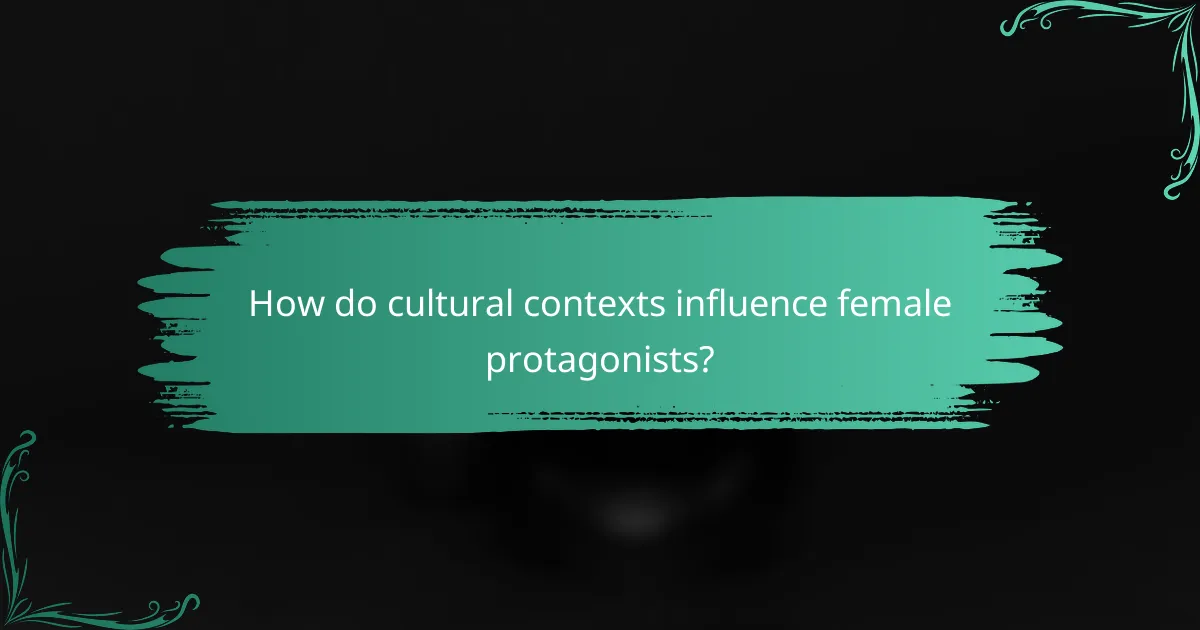
How do cultural contexts influence female protagonists?
Cultural contexts significantly shape female protagonists by defining their roles, challenges, and growth within narratives. These influences can vary widely based on societal norms, values, and historical backgrounds, impacting how women are portrayed and what they symbolize in literature and media.
Representation in diverse cultures
Diverse cultures offer a rich tapestry of female representation, each with unique characteristics and challenges. For instance, in some cultures, female protagonists may embody traditional roles, while in others, they may challenge societal expectations and pursue independence. This variation can lead to a broader understanding of femininity and strength across different narratives.
Examples include the strong-willed women in African folklore, who often take on leadership roles, contrasted with the more subdued portrayals in certain Asian narratives, where familial duty may dominate. Such differences highlight the importance of cultural context in shaping character development and audience perception.
Impact of historical settings
Historical settings play a crucial role in defining the journeys of female protagonists. The time period in which a story is set can dictate the opportunities and limitations faced by women, influencing their character arcs. For example, a female protagonist in a Victorian-era novel may grapple with strict societal norms, while one in a contemporary setting may experience greater freedom and agency.
Understanding the historical context allows readers to appreciate the complexities of a character’s growth. It is essential to consider how events such as wars, social movements, or technological advancements impact women’s roles and their narratives. This awareness can deepen the connection between the audience and the protagonist’s journey.
